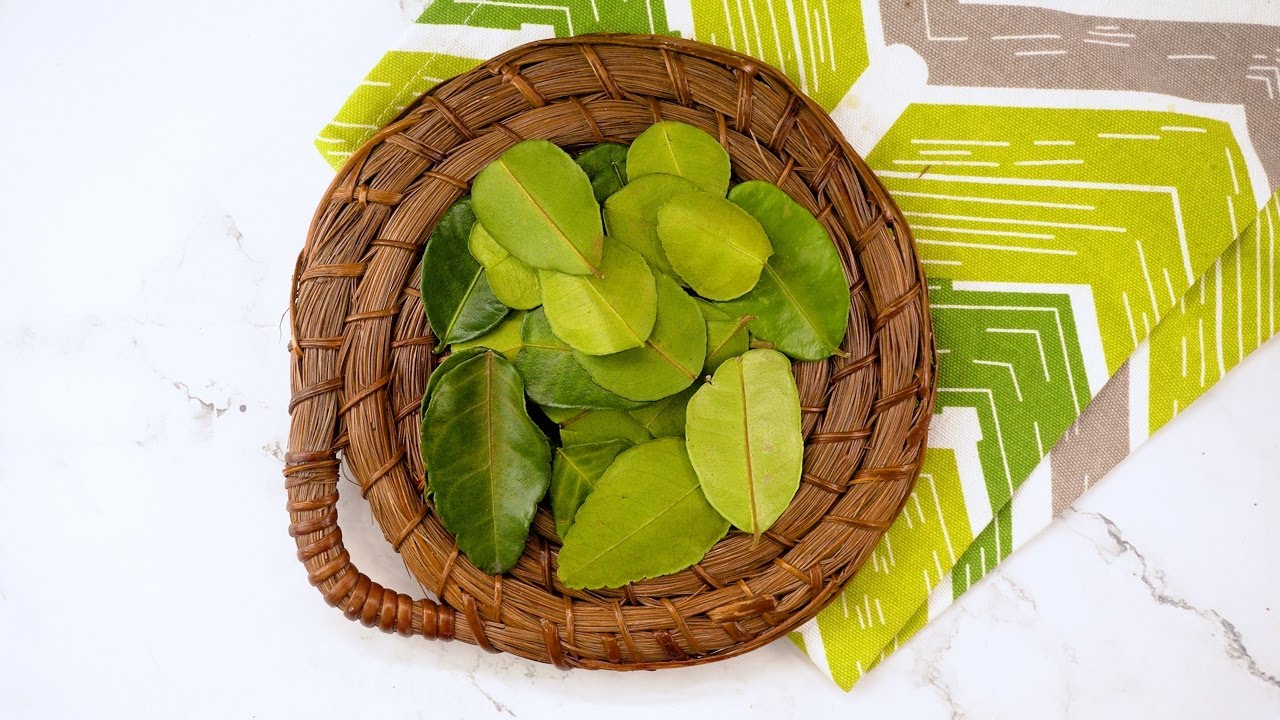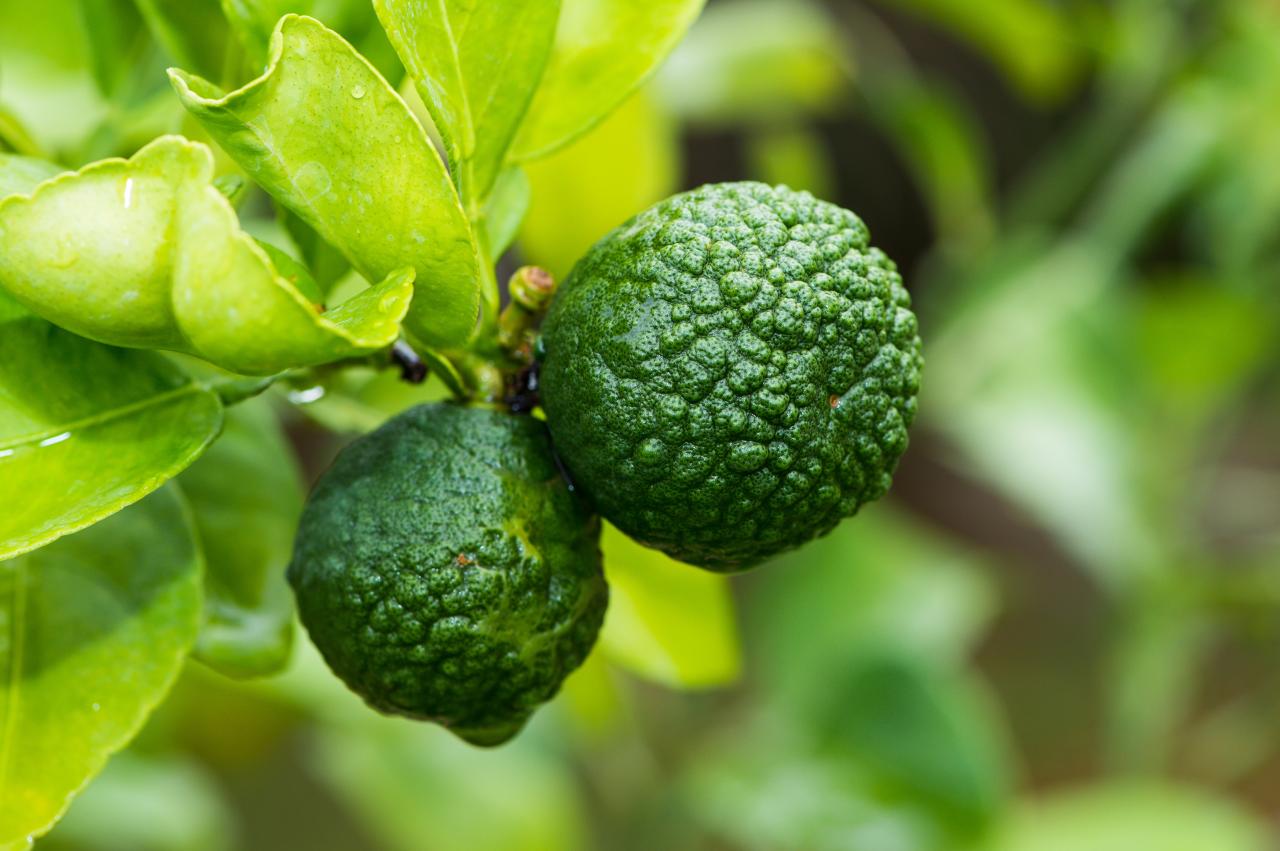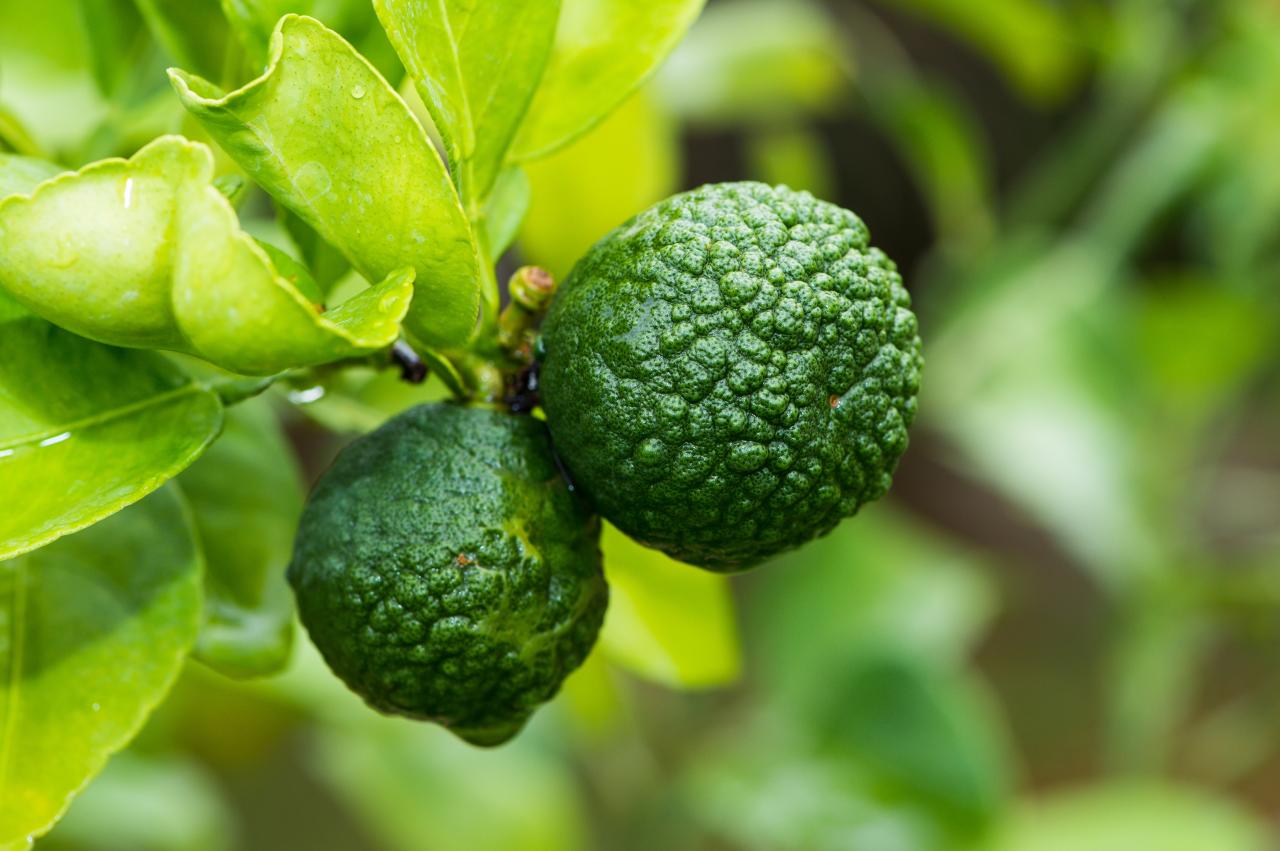How to Grow and Use Kaffir Lime Leaf: Tips for Fresh and Flavorful Cooking sets the stage for this enthralling narrative, offering readers a glimpse into a story that is rich in detail and brimming with originality from the outset.
The unique aroma and flavor of kaffir lime leaves, a staple in Southeast Asian cuisine, have captivated palates worldwide. These aromatic leaves add a distinct citrusy and slightly floral note to dishes, elevating them to new heights of culinary excellence.
This guide delves into the world of kaffir lime leaves, exploring their cultivation, harvesting, and diverse culinary applications. From planting your own kaffir lime tree to mastering the art of incorporating these leaves into your favorite recipes, this comprehensive guide provides a step-by-step journey into the fascinating realm of kaffir lime leaves.
Introduction to Kaffir Lime Leaves

Kaffir lime leaves, also known as makrut lime leaves, are a unique and versatile ingredient used in various cuisines worldwide. Their distinct aroma and flavor profile add a refreshing and citrusy zest to dishes, making them a popular choice for both savory and sweet applications.
These leaves offer a complex flavor that is both citrusy and herbaceous, with hints of lemongrass, ginger, and mint. This unique combination makes them an excellent addition to a wide range of dishes, from curries and soups to stir-fries and desserts.
Nutritional Benefits of Kaffir Lime Leaves
Kaffir lime leaves are not only flavorful but also packed with nutritional benefits. They are a good source of vitamins, minerals, and antioxidants, which are essential for maintaining good health.
- Vitamin C:Kaffir lime leaves are a good source of vitamin C, an antioxidant that helps boost the immune system and protect against cell damage.
- Vitamin A:These leaves also contain vitamin A, which is important for maintaining healthy vision, skin, and immune function.
- Antioxidants:Kaffir lime leaves are rich in antioxidants, which help protect the body from damage caused by free radicals. These antioxidants contribute to overall health and may reduce the risk of chronic diseases.
Growing Kaffir Lime Trees: How To Grow And Use Kaffir Lime Leaf: Tips For Fresh And Flavorful Cooking

Cultivating your own kaffir lime tree can be a rewarding experience, providing you with a continuous supply of these fragrant leaves for your culinary creations. Whether you start from seed or a cutting, the process requires patience and understanding of the tree’s needs.
Kaffir lime leaves, with their distinctive aroma and flavor, can elevate any dish. They are versatile and can be used fresh or dried, adding a unique zest to curries, soups, and even desserts. While cultivating kaffir lime trees may require some patience, the reward of fresh, fragrant leaves is well worth the effort.
For those seeking a similar green thumb challenge, consider exploring the world of ivy propagation, as outlined in The Ultimate Guide to Ivy Propagation – Get Lush Green Vines. Whether you’re nurturing fragrant herbs or lush vines, the journey of plant propagation offers a rewarding connection with nature and the satisfaction of creating something beautiful.
Planting Kaffir Lime Seeds or Cuttings
To successfully grow a kaffir lime tree, you can choose to start from seeds or cuttings. Both methods have their advantages and disadvantages.
- Planting Seeds:
- Start by soaking the seeds in warm water for 24 hours to soften the outer shell. This helps improve germination rates.
- Fill a seed tray or small pots with a well-draining potting mix. Sow the seeds about 1/2 inch deep and water them thoroughly.
- Place the tray or pots in a warm, sunny location. Maintain a temperature of around 70-80°F (21-27°C) for optimal germination.
- Keep the soil moist but not waterlogged. Germination can take several weeks to a few months.
- Once the seedlings have a few sets of true leaves, they can be transplanted into larger pots or directly into the ground.
- Planting Cuttings:
- Select healthy, mature stems from a kaffir lime tree. Cuttings should be about 6-8 inches long and have at least 3-4 nodes (where leaves grow).
- Remove the leaves from the bottom 2-3 inches of the cutting.
- Dip the cut end of the cutting in rooting hormone to promote root growth.
- Plant the cuttings in a pot filled with a well-draining potting mix, ensuring that the nodes are buried below the soil line.
- Water the cuttings thoroughly and keep them in a warm, humid environment. Rooting can take several weeks to a few months.
Ideal Soil Conditions and Climate
Kaffir lime trees thrive in well-drained soil with a slightly acidic pH of 6.0-6.5. They prefer a warm, sunny location with temperatures between 70-90°F (21-32°C).
- Soil:
- A well-draining soil mix is crucial for kaffir lime trees to prevent root rot. You can create a suitable mix by combining potting soil, compost, and perlite or sand.
- The soil should be rich in organic matter, providing essential nutrients for healthy growth.
- Avoid planting kaffir lime trees in heavy clay soils, which can lead to poor drainage and root problems.
- Climate:
- Kaffir lime trees are native to Southeast Asia and prefer a tropical or subtropical climate.
- They can tolerate some frost, but prolonged exposure to freezing temperatures can damage the tree.
- In areas with cold winters, it’s best to grow kaffir lime trees in containers and bring them indoors during the colder months.
Watering, Fertilizing, and Pruning
Proper watering, fertilization, and pruning are essential for maintaining a healthy and productive kaffir lime tree.
- Watering:
- Water kaffir lime trees deeply and regularly, especially during hot, dry weather.
- Allow the soil to dry slightly between waterings to prevent overwatering, which can lead to root rot.
- During the winter months, reduce watering frequency as the tree is dormant.
- Fertilizing:
- Fertilize kaffir lime trees every 4-6 weeks during the growing season (spring and summer) with a balanced fertilizer, such as 10-10-10.
- Avoid over-fertilizing, as this can damage the roots and lead to leaf burn.
- You can also use organic fertilizers, such as compost or manure, to improve soil fertility.
- Pruning:
- Prune kaffir lime trees in late winter or early spring before new growth emerges.
- Remove any dead, diseased, or crossing branches to promote air circulation and sunlight penetration.
- Pinch back the tips of new growth to encourage bushier growth and more leaf production.
Common Pests and Diseases
While generally hardy, kaffir lime trees can be susceptible to certain pests and diseases.
- Pests:
- Citrus leafminer:These tiny insects burrow into the leaves, causing unsightly brown trails.
- Scale insects:These small, armored insects suck sap from the leaves and stems, weakening the tree.
- Aphids:These tiny, soft-bodied insects can cause leaf curl and distortion.
- Diseases:
- Citrus greening (Huanglongbing):This bacterial disease is a serious threat to citrus trees, causing yellowing and stunting of leaves.
- Citrus canker:This bacterial disease causes raised, corky lesions on leaves, stems, and fruit.
- Root rot:This fungal disease occurs when the soil is poorly drained and the roots are constantly wet.
Solutions for Pests and Diseases
- Pests:
- Citrus leafminer:Use insecticidal soap or neem oil to control leafminer infestations.
- Scale insects:Scrape off scale insects with a fingernail or use horticultural oil to smother them.
- Aphids:Introduce beneficial insects, such as ladybugs or lacewings, to control aphid populations.
- Diseases:
- Citrus greening:There is no cure for citrus greening, so prevention is key. Use disease-free planting material and practice good sanitation.
- Citrus canker:Remove and destroy infected branches or leaves. Copper fungicides can help prevent the spread of the disease.
- Root rot:Improve soil drainage and avoid overwatering. Fungicides can help control root rot infections.
Harvesting Kaffir Lime Leaves
Harvesting kaffir lime leaves at the optimal time is crucial for achieving their full flavor potential. The leaves should be harvested when they are young and tender, as they are more aromatic and flavorful than older leaves.
Methods for Harvesting Kaffir Lime Leaves, How to Grow and Use Kaffir Lime Leaf: Tips for Fresh and Flavorful Cooking
There are several methods for harvesting kaffir lime leaves, each with its own advantages and disadvantages.
- Plucking:This is the most common method, involving simply plucking the leaves from the branches. It is a gentle method that minimizes damage to the plant.
- Cutting:Using a sharp knife or shears, you can cut the leaves from the branches. This method is faster than plucking but can be more damaging to the plant.
- Pruning:Pruning involves removing entire branches, which can be beneficial for shaping the plant and promoting new growth. However, it is best to avoid pruning during the fruiting season.
Storing Kaffir Lime Leaves
Proper storage is essential for preserving the freshness and aroma of kaffir lime leaves.
- Refrigeration:Storing kaffir lime leaves in a sealed plastic bag in the refrigerator can extend their freshness for up to a week.
- Freezing:Freezing kaffir lime leaves is a great way to preserve them for longer periods. To freeze them, simply wash and dry the leaves, then place them in a freezer bag and freeze.
- Drying:Drying kaffir lime leaves is another option for long-term storage. You can dry them in a dehydrator or by air-drying them in a cool, dry place.
Culinary Uses of Kaffir Lime Leaves

Kaffir lime leaves, with their distinctive aroma and flavor, are a staple ingredient in Southeast Asian cuisine, adding a unique citrusy and slightly herbal note to various dishes. Their versatility allows them to be used in various ways, from whole leaves to infused oils, enriching the culinary experience.
Recipes Featuring Kaffir Lime Leaves
Kaffir lime leaves are a key ingredient in numerous Southeast Asian dishes, lending a distinctive citrusy and herbal flavor to various cuisines.
Cuisine |
Dish |
Description |
|---|---|---|
Thai |
Tom Kha Gai (Thai Coconut Soup with Chicken) |
A creamy and fragrant soup featuring chicken, coconut milk, galangal, lemongrass, and kaffir lime leaves. |
Vietnamese |
Bun Cha (Vietnamese Vermicelli with Grilled Pork) |
A popular street food dish consisting of grilled pork, vermicelli noodles, fresh herbs, and a dipping sauce often featuring kaffir lime leaves. |
Indonesian |
Rendang (Beef Curry) |
A rich and flavorful beef curry cooked in coconut milk, spices, and kaffir lime leaves, resulting in a tender and aromatic dish. |
Malaysian |
Nasi Lemak (Coconut Rice) |
A fragrant rice dish cooked with coconut milk, pandan leaves, and often includes kaffir lime leaves for an extra citrusy kick. |
Preparing Kaffir Lime Leaves for Cooking
Kaffir lime leaves can be used whole, chopped, or infused in oil, depending on the desired outcome and recipe.
Whole Leaves
Whole kaffir lime leaves are often used in soups, stews, and curries, adding a subtle citrusy flavor and aroma. They are typically removed before serving.
Chopped Leaves
Chopping kaffir lime leaves releases more of their flavor and aroma. They are commonly used in stir-fries, sauces, and marinades.
Infused Oil
Infusing oil with kaffir lime leaves creates a fragrant oil that can be used to enhance the flavor of various dishes. To infuse oil, simply heat oil in a pan with kaffir lime leaves and simmer until the oil is infused with the aroma.
Using Kaffir Lime Leaves in Dishes
Kaffir lime leaves are a versatile ingredient that can be used in a variety of ways to enhance the flavor of dishes.
Whole Leaves
Whole kaffir lime leaves are typically added to soups, stews, and curries during the cooking process. They are often removed before serving, as they can become tough and bitter.
Chopped Leaves
Chopped kaffir lime leaves can be added to stir-fries, sauces, and marinades. They release more of their flavor and aroma when chopped.
Infused Oil
Kaffir lime infused oil can be used to add a citrusy and herbal flavor to various dishes, including stir-fries, noodles, and rice.
Pairing Kaffir Lime Leaves with Other Ingredients
Kaffir lime leaves complement a wide range of ingredients, enhancing their flavor and creating complex and aromatic dishes.
Pairing with Seafood
Kaffir lime leaves pair well with seafood, such as fish, shrimp, and crab, adding a refreshing citrusy note that balances the richness of the seafood.
Pairing with Chicken and Pork
Kaffir lime leaves can also be used to flavor chicken and pork dishes, creating a harmonious blend of citrus, herb, and meat flavors.
Pairing with Coconut Milk
Kaffir lime leaves are often used in dishes with coconut milk, such as curries and soups, adding a bright and aromatic counterpoint to the richness of the coconut milk.
Pairing with Spices
Kaffir lime leaves can be paired with various spices, such as ginger, lemongrass, galangal, and chili peppers, to create complex and flavorful dishes.
Kaffir Lime Leaf Recipes
Kaffir lime leaves are a versatile ingredient that can be used in a variety of dishes. They add a unique citrusy and slightly peppery flavor that complements many cuisines. From curries to soups, stir-fries to desserts, there are countless ways to incorporate these fragrant leaves into your cooking.
Popular Kaffir Lime Leaf Recipes
Kaffir lime leaves are commonly used in Southeast Asian cuisine, particularly in Thai, Vietnamese, and Indonesian dishes. They are often used in curries, soups, stir-fries, and marinades. Here are some popular recipes that feature kaffir lime leaves:
- Thai Green Curry: This classic Thai dish is made with coconut milk, green chilies, lemongrass, galangal, and kaffir lime leaves. The leaves impart a bright citrusy flavor that balances the richness of the coconut milk and the heat of the chilies.
Cultivating kaffir lime leaves is a rewarding endeavor, adding a unique citrusy flavor to your dishes. While the leaves themselves are readily available, growing your own offers a sense of satisfaction and allows you to harvest them fresh. Much like the joy of cultivating your own herbs, you can also propagate roses from cuttings, as outlined in Secrets Revealed: How To Propagate Roses From Cuttings for Unbelievable Growth , which offers a detailed guide for achieving incredible growth.
Similar to propagating roses, kaffir lime trees can be propagated from cuttings, allowing you to expand your garden and enjoy the fresh fragrance and zest of these flavorful leaves.
The green curry is typically served with rice, vegetables, and meat or tofu.
- Tom Kha Gai (Thai Coconut Soup): This comforting soup is made with chicken, coconut milk, galangal, lemongrass, and kaffir lime leaves. The leaves add a refreshing citrusy note that complements the creamy coconut milk and the savory chicken broth.
- Vietnamese Pho: This popular noodle soup is made with a flavorful broth, rice noodles, and various toppings, including herbs, bean sprouts, and lime wedges. Kaffir lime leaves are sometimes added to the broth for an extra layer of citrusy flavor.
- Malaysian Rendang: This rich and flavorful curry is made with beef, coconut milk, spices, and kaffir lime leaves. The leaves add a citrusy and slightly peppery flavor that complements the other spices in the curry.
- Thai Basil Fried Rice: This popular street food dish is made with stir-fried rice, basil, garlic, chilies, and kaffir lime leaves. The leaves add a bright citrusy flavor that balances the savory and spicy flavors of the rice.
Signature Dish: Thai Green Curry with Chicken
This recipe features the vibrant flavors of Thai green curry, enhanced by the aromatic kaffir lime leaves. The combination of coconut milk, green chilies, lemongrass, galangal, and kaffir lime leaves creates a complex and delicious curry that is both comforting and satisfying.
Ingredients:
- 1 tablespoon vegetable oil
- 1 onion, chopped
- 2 cloves garlic, minced
- 1 inch ginger, minced
- 1 stalk lemongrass, bruised
- 1 inch galangal, sliced
- 4 kaffir lime leaves, torn
- 1 cup green curry paste
- 1 (14-ounce) can coconut milk
- 1 cup chicken broth
- 1 pound boneless, skinless chicken breasts, cut into 1-inch pieces
- 1 cup mixed vegetables (such as bell peppers, zucchini, and green beans)
- 1/2 cup Thai basil leaves
- Salt and pepper to taste
- Cooked rice, for serving
Instructions:
- In a large pot or Dutch oven, heat the oil over medium heat. Add the onion and cook until softened, about 5 minutes.
- Add the garlic, ginger, lemongrass, galangal, and kaffir lime leaves and cook for 1 minute more.
- Stir in the green curry paste and cook for 1 minute, until fragrant.
- Add the coconut milk, chicken broth, and chicken. Bring to a boil, then reduce heat and simmer for 15 minutes, or until the chicken is cooked through.
- Stir in the vegetables and basil leaves. Cook for 5 minutes, or until the vegetables are tender.
- Season with salt and pepper to taste.
- Serve hot over rice.
Visual Description
The Thai green curry with chicken is a vibrant and colorful dish. The curry sauce is a rich, emerald green color, with flecks of white from the coconut milk and green chilies. The chicken is tender and flavorful, and the vegetables are cooked to perfection.
The dish is garnished with fresh basil leaves, which add a fragrant aroma and a touch of green to the dish.
Role of Kaffir Lime Leaves
The kaffir lime leaves play a crucial role in this dish. They add a bright citrusy flavor that balances the richness of the coconut milk and the heat of the green chilies. The leaves also impart a subtle peppery note that adds complexity to the flavor profile.
The aroma of the kaffir lime leaves is also essential, adding a fresh and fragrant element to the curry.
Last Recap
Embarking on the journey of growing and using kaffir lime leaves is an enriching experience that unlocks a world of culinary possibilities. From the fragrant aroma of freshly harvested leaves to the satisfying taste of a perfectly prepared dish, the journey offers a unique blend of satisfaction and culinary delight.
As you delve deeper into the world of kaffir lime leaves, you’ll discover that the journey itself is as rewarding as the destination. Whether you’re a seasoned chef or a culinary enthusiast, this guide provides the tools and inspiration to elevate your cooking with the unique flavors of kaffir lime leaves.
Essential FAQs
What is the best way to store kaffir lime leaves to maintain their freshness?
Store kaffir lime leaves in an airtight container in the refrigerator for up to a week. You can also freeze them for longer storage, but they may lose some of their flavor.
Can I use kaffir lime leaves in place of regular lime juice?
While both have citrusy flavors, kaffir lime leaves have a more complex and distinct aroma than lime juice. They are not interchangeable, but you can use them together for a more layered flavor profile.
Are kaffir lime leaves edible?
Yes, kaffir lime leaves are edible, but the tough texture of the leaves is often removed before consumption. You can use them whole, chopped, or infused in oil for different culinary applications.
